Recent Posts
- Cultivating A Champion Culture: Balancing Performance and People in Animal Health
- How Stable are Earnings in Animal Health? Results of the Animal Health Jobs 2025 Salary Survey
- Entry Fees for the Race for Talent: Results of the Animal Health Jobs 2025 Salary Survey
- Looking In The Gift Horse’s Mouth: The Pros and Cons of Counteroffers in Animal Health
- Beyond the Hire: Why Animal Health Needs More "Relationshipping," and Less Recruiting
Most Popular
-

Entry Fees for the Race for Talent: Results of the Animal Health Jobs 2025 Salary Survey
-

News to Know from Brakke Consulting’s 2025 Animal Health Industry Overview
-
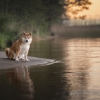
How Stable are Earnings in Animal Health? Results of the Animal Health Jobs 2025 Salary Survey
-

How Will Artificial Intelligence Change Jobs In Animal Health?
-

Different Kettles of Fish: Results of the Animal Health Jobs Spring 2023 Attitudinal Survey
Different Kettles of Fish: Results of the Animal Health Jobs Spring 2023 Attitudinal Survey

Executive Summary
“One of the most rewarding aspects of working in the animal health industry is the opportunity to make a positive impact on the lives of animals and their owners”
The third annual Animal Health Jobs Candidate Attitudinal Survey revisited questions posed in 2021 and 20221,2 about job seekers’ attitudes towards the animal health industry, individual companies and jobs, and their perceptions of the industry’s future. Responses were evaluated across gender, job level, and years of experience.
The overall positive view of the animal health industry was consistent with results in previous years. Respondents again revealed general satisfaction with their jobs and their companies, and the “stickiness” of the animal health industry that we have come to expect.
This report describes how employees’ engagement and reasons for staying in a job change with level and years of experience. It identifies the incumbents most likely to be disengaged and those most likely to be flight risks. For the first time, the report provides a “biography” of the prototypical animal health employee at 3 career stages: Individual contributor, first level manager (manager of people) and senior manager (manager of managers), describing their attitudes and motivations, and suggesting ways to develop and retain each.
The concerns we raised in 2022 of a threat to the generally positive animal health industry culture remains. We believe that these risks can be mitigated with prompt, thoughtful managerial interventions.
Introduction
The animal health industry touches the lives of livestock producers, horse owners, pet owners, and anyone who uses animal products. It serves therapy dogs, prize-winning bulls, and record-setting racehorses, along with pets of all kinds, providing them with food, medical diagnostics, vaccines, parasiticides, and pharmaceuticals, as well as a range of services.
Leaders across animal health are debating the impact of the return to a post-pandemic “new normal” on employee attitudes. Will employees still be equally committed to their jobs, or have recent experiences changed the importance of work in their lives? To address some of their questions, we explored current employee and candidate perceptions of the state of the animal health industry and its future, and their attitudes about their current jobs and companies. Responses are evaluated by gender, years of industry experience, and job level. Because Animal Health Jobs is a job board focused exclusively on the animal health and animal nutrition industry, survey participants had first-hand knowledge of the industry’s culture and norms.
Participants were members of the Animal Health Jobs database in February 2023. Basic statistical calculations of the results were conducted; statistical significance was set at 90% (p<0.1) and indicated in figures with an asterisk (*).
Demographics: Who’s in the barn?
Gender and geography
The respondent group skewed slightly female: study participants were 56% female and 42% male, while 2% preferred not to answer. This is a slightly more female-weighted population than the US Census Bureau’s estimate of 51% female.3
As in past surveys, the vast majority of participants (98%) were US-based. This year’s survey population was again distributed across the country: 41% from the South, 16% from the West, 21% from the Midwest and 19% from the Northeast.
The pecking order: time and seniority
Consistent with the 2021 and 2022 surveys, 2023 respondents were highly experienced, with 63% reporting more than 15 years in the industry.1,2 Three-quarters (77%) of respondents were working in animal health at the time of the survey. Of these, 90% had spent their entire career in the industry, as had more than half (52%) of all survey participants. Significantly more women than men were lifetime insiders, as were significantly more managers of managers compared to first level managers and individual contributors.
Approximately two-thirds of survey participants (64%) were individual contributors. Almost one quarter (24%) were first-level managers ('managers of people'), and 11% were managers of managers. This distribution continues to reflect the importance of online jobs boards like Animal Health Jobs to fill individual contributor and first level manager positions. Senior positions such as managers of managers and executives are generally filled by specialized recruiters like the Brakke Executive Search team.
Engagement: Are you here for the long term?
Employee engagement directly affects business performance. Are your employees committed to your company? How much energy do they invest in achieving your goals? Are they putting their best efforts into supporting customers and solving problems?
Our questions about engagement covered employee happiness at work, willingness to recommend their company to others who are looking for jobs, and the different levers that convince an employee to stay put.
Familiar fields
The deep connection that animal health people feel for the industry remains one of its most consistent aspects. Two-thirds (67%) of respondents reported that they either plan to work only in animal health, or that it would “take a lot” to make them leave for another industry (Figure 1). Respondents with 5 or fewer years of working experience, and individual contributors, gave significantly stronger positive responses to this question than their comparator groups.
I love my pasture: Why employees stay
Managers who understand why valuable employees stay can leverage these insights to retain their best talent. As in previous years, we asked survey participants who were not actively looking for a new position to rank predefined answers to the question, "What makes you stay at your current company?"
The ranking in order of importance (most to least important), was as follows:
- My job - the work is meaningful
- My team - I really enjoy the people I work with
- My compensation - my salary, benefits, and financial incentives
- My manager - I am supported, listened to, and respected
Once again, the reasons for remaining ranked closely together; the spread between individual factors within an experience cohort never exceeded 0.94 points. Instead, the drivers for staying changed with years of experience (Figure 2) and job level.

At the start of a person’s career (0-5 years), the manager ranks most highly. A manager who appreciates, listens to, and respects her team members can have a tremendous impact on someone early in their working life, making the difference between a successful start and a catastrophe.
At 6-10 years of experience, the team is the main driver for staying, as the employee develops a network of valued contacts. As they become established in their career and develop deeper expertise (11-15 years’ experience), meaningful work becomes most important, significantly more so than for other cohorts.
Between 16 and 25 years into the workforce, compensation matters the most, and towards the end of the career (more than 26 years), close relationships with team members again take priority.
Among individual contributors, meaningful work is most important (Figure 3). For first-level managers compensation drives the decision to stay. Senior managers place significantly more importance on their team and colleagues than do those deeper in the organization.

I was not working, because it was a passion
“I was not working, because it was a passion.” That’s how one of our respondents described their career in animal health. In using free-text question to describe their animal health careers, respondents made it clear that they still feel a strong emotional connection to the industry’s mission.
In the 2022 survey, the top 3 words respondents used to describe their careers were fulfilling/impactful, rewarding, and fun/enjoyable.2 The 2023 survey results were similar. The three top descriptions were rewarding, challenging, and descriptions of meeting and working with wonderful people. Appreciation for variety and flexibility rounded out the top 4. Close behind those were comments relating to fulfilment and the mission or meaning of the work (Figure 4).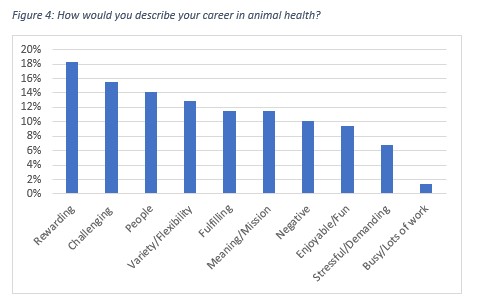
“I love using my scientific knowledge, my business prowess, and my people skills to advance my success. Bonus: Where else do you get to snuggle puppies?”
Happy as clams
More than twice as many participants reported being happy at work than not happy (54% vs. 24%), a slight improvement over 2022 and 2021.1,2 Levels of happiness at work tend to increase with time (Figure 5). After a bumpy start in the first few years, most respondents reported being happy at work.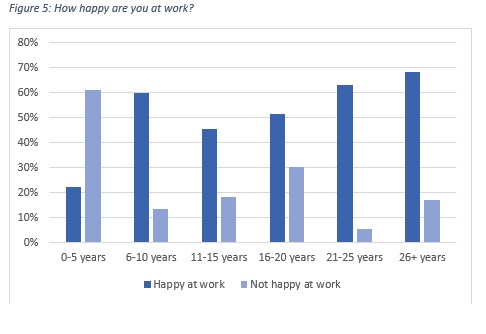
Overall work happiness is consistent across job levels, with more than half of individual contributors (53%), managers of people (56%) and managers of managers (53%) describing themselves as happy at work.
The forecast is mostly sunny
Animal health continues to be seen as a stable industry (pun intended). One respondent even used the phrase “recession-proof” when describing their career. Consistent with previous years, 77% of this year’s respondents expect a bright future for animal health.
Optimism reaches all levels of the business, with 82% of senior managers, 78% of first level managers and 76% of individual contributors all agreeing that animal health has a bright future, with an overall rating of 8 on a scale of 1 to 10.
Employees who see a bright future are more likely to recommend their company to friends and contacts as a great place to work. These employee referrals can be the source of a company's best hires. Most animal health employees (60%) would recommend their company as a good place to work.
What would you miss if you left?
A second free-text question asked, "If you left the animal health industry, what would you miss the most?" (Figure 6). The answers revealed the multi-dimensional advantages of a career in animal health.
Our industry is about people as well as animals; colleagues and customers influence levels of engagement. A majority of our respondents (55%) answered this question with references to people: their colleagues, managers, and customers.
Animals, and a shared mission of making a difference for these special creatures, also bring us together. Twenty percent (20%) of responses referred to animals, and 18% to making a difference for animals or their people.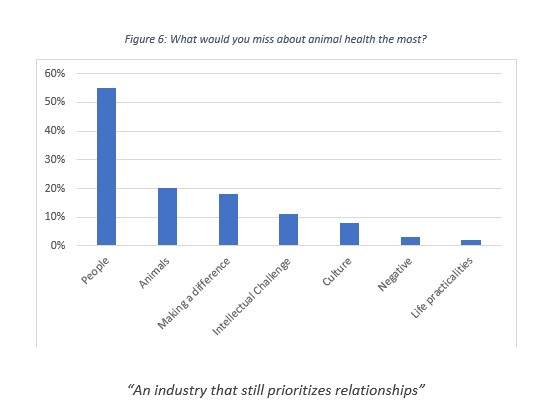
One fox or a whole skulk of them? Trends worth watching
In 2022, we raised concerns that the special animal health culture, which had been so strong and positive for so many years, could be under threat.2 The 2023 survey highlights similar potential issues, in gender diversity, employee stability and happiness. While the fox has not yet invaded the henhouse, there may be several of them now sniffing around.
Gender diversity in management: still a work in progress
Despite decades of attention, the top of the animal health management pyramid is still dominated by men. Of the top 10 animal health companies, only one, Zoetis, is led by a female CEO.5
Our survey respondent population reflected this. Nearly three-quarters (72%) of female respondents were individual contributors, vs. 56% of male respondents. More than twice as many males than females were managers of managers (16% vs. 7%). We expect to see more females in managements positions in the future, and will look for this change in the 2024 survey.
Trouble by any other name
When respondents were asked to describe their careers in 2022, the fourth most common set of terms was negative, with 12% using words like frustrating and stressful. Based on these results, we raised concerns about a potential shift in the industry culture and respondents’ level of engagement with their jobs. We advised managers to watch for a fox circling the henhouse, to address employee concerns and to monitor their job satisfaction.2
This year’s results were somewhat better than 2022: the top 6 career descriptions were positive. Still, one in 10 descriptions used negative phrases, and 7% called their careers stressful and demanding (Figure 4). Other negative comments highlighted low pay, pressure from company consolidation, and ageism in the hiring process. One respondent, a veterinarian, left the industry entirely.
Hanging onto happiness
Happiness at work among all respondents is slowly eroding, from a mean score of 6.3 on a 10-point scale in 2021 to 5.95 in 2023, almost a 17% drop in two years. 1
Respondents just starting their career reported the lowest scores for happiness. Those in the first 5 years of their career were the only group in which a majority described themselves as not happy (Figure 5). Take heed, though: roughly one-third of respondents at each job level were neither particularly happy nor unhappy – they may actually be mildly disengaged, doing what is necessary at work, but not much more. We wonder how much of this decline was due the changes brought on by the COVID-19 pandemic.
Even happy employees have an eye out for their next great opportunity. While 39.5% of those looking for new jobs in the industry are not happy in their current job, another 37.2% of those looking for a change are happy. Is your company giving its valuable employees enough chances to advance? Or must they leave to find the opportunities they seek?
In search of greener pastures
While animal health companies report challenges in the hiring process, with 60% failing to meet their hiring goals in 2022, the problem is not lack of potential candidates.4 More than half (54%) of our survey respondents are actively looking for new opportunities, with 29% looking only within animal health and 24% open to options both within and outside. An additional 35% of incumbents are open to hearing about new positions even while not actively looking to move.
Individual contributors are likely to be job hunting; half of them are actively looking for their next role. First level managers, however, are the greatest flight risks. Nearly two thirds (64%) are actively searching for their next position, and another 33% are open to spontaneous opportunities. That means 97% of first level managers could be ready to leave. How can leaders convince them to stay?
Stay away from my barn
A worrisome 18% of respondents, almost one in five, are not likely to recommend their company as a great place to work. Not surprisingly, this difference was especially dramatic in people with less than 6 years of experience. Over the past 3 years, these results have worsened, with significantly fewer new entrants willing to recommend their company in 2023 vs. 2021 (Figure 7).1
This is another effect of a bumpy career start, not on the employee but on the business. A reputation as a good place to work is an invaluable tool for enhancing a company’s talent pipeline.
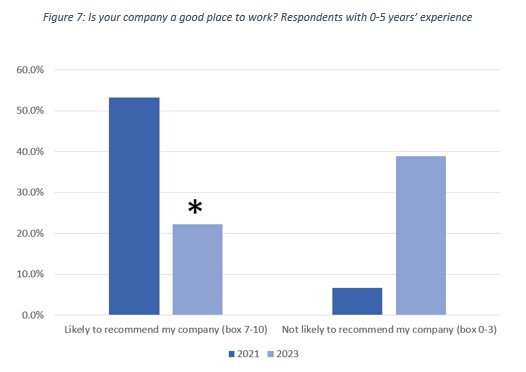
In our recent hiring survey, hiring managers reported that misaligned expectations between applicants and companies was one of the top reasons they were unable to meet their hiring goals. Honest discussions of company culture, career development and compensation during the hiring process can help align company and candidate/employee expectations. Robust onboarding programs support new employees in adjusting to the company culture. Continuing these activities throughout an employee’s tenure can increase employee satisfaction strengthen a company’s talent pipeline at all levels.
The forecast: Bring an umbrella
In the 2022 survey, we noted the potential for clouds on the horizon. While the outlook remains sunny, the number of people who feel that the future is not bright has nearly tripled since 2021, 8.7% up from 3.3%, a significant increase.1 Most of that change comes from individual contributors, 8.3% of whom now see the future as not bright, vs. 3.0% in 2021.1
Uncertainty about the future can distract employees and encourage them to seek potentially more stable options. While managers cannot control macroeconomic trends or share insights into potential business transactions, speaking honestly about challenges and asking employees for their ideas to overcome them can give them greater confidence in the future.
Look out for Reynard and friends
The fox we warned of in 2022 is still sniffing around the henhouse, though he and his pack have not yet broken through the door. External economic pressures on the industry remain. The top 5 companies still hold 64% of industry value, and the emphasis on efficiency means fewer positions, especially at the top.5
For more on the state of the industry and predictions for the future, see the Brakke Annual Industry Overview for 2023.5
Leaders in animal health cannot relax their vigilance: focusing employee efforts on work that matters, eliminating unnecessary stressors, providing transparency about the future, and developing employees according to their individual goals and abilities can relieve pressure and improve employee engagement.
Meet the Herd Members: The Typical Animal Health Incumbent
Who is the prototypical animal health employee? In this section, we describe a representative incumbent at the 3 surveyed job levels and comment on our observations.
The Individual Contributor: Considering different paths
In 2023, the individual contributor is likely to be a woman. During her 19-year career, she has worked inside and outside the industry and has a strong preference for remaining within animal health. Twice as likely to be happy at work than not happy (53% vs. 26%), she is nearly three times as likely to recommend her company as a good place to work than to warn others away.
This individual contributor wants career growth: she is likely to be looking for a new position, or if not actively looking, is certainly open to hearing about new opportunities. She places the greatest value on meaningful work, with fair compensation a very close second, followed by the people she works with and having a positive relationship with her direct manager. Overall, she sees a bright future for the animal health industry, with a mean rating of 7.7 on a 10-point scale.
This individual contributor may be the core of your team: knowledgeable, reliable, and with deep relationships with customers and colleagues. There is a nearly 50% chance that she is actively looking for a new job as you read this. Retaining her requires giving her new challenges and opportunities to expand her skills, providing fair compensation, and a nuanced understanding of her career goals. She may want to take on a managerial role, or further develop her expertise. The only way to know is to ask her.
Companies looking to improve gender diversity in higher ranks understand that promoting talented women from individual contributor to first line manager is also the first step along this path.
The Manager of People: Ready to jump
In 2023, the first level manager, who directly manages a team of individual contributors, is roughly equally likely to be a woman or a man. Over their median 18-year career, they are more likely than not to have remained in animal health.
Almost half of these managers would prefer to stay in animal health for their entire career. Importantly, nearly two-thirds (64%) are looking for new jobs and may be willing to leave animal health to find them. An additional 33% of first-line managers are not actively job hunting but are interested in hearing about potential opportunities. Every first line manager can thus be considered at risk of leaving for a new role.
First line managers know their value: compensation is their most important reason for staying in a job, with meaningful work a close second. An enjoyable team and a good relationship with their manager rank third and fourth in importance.
First line managers are more than twice as likely to be happy at work than not happy (56% vs. 22%). When it comes to referrals, 61% would recommend their company, while only 8% would not.
More than three-quarters of first-line managers see a bright future for the animal health industry; their mean rating for the future (on a 10-point scale) is 7.4.
Senior managers must think carefully about which of their first-line managers they want to retain and develop, and how to do so. Compensation, which is not always a question of dollars and cents, must be part of that equation. Development plans must be flexible enough to allow for a host of life situations, to ensure that both women and men are prepared to advance to the next level. This tier has a nearly balanced division of men and women; keeping that balance at the next tier requires giving both genders equal preparation and opportunities.
The Manager of Managers: Deeply rooted but still flexible
In 2023, the typical manager of managers in the animal health job industry is far more likely to be male (59%) than female (35%), with a median career duration of 23 years, significantly longer than either individual contributors or first-line managers. Nearly three-quarters of the managers of managers have spent their entire career in animal health.
Compared to their less-senior colleagues, the manager of managers is least likely to want to move on, with 29% expressing no wish to change jobs. Don’t take them for granted, though: 47% are actively job hunting and 18% are open to being approached about an opportunity.
Managers of managers value the people they work with most highly as a reason to stay, with compensation and meaningful work ranked second and third in importance. Least important for these senior employees is their relationship with their direct manager; we speculate that they have learned to get along with managers of many styles.
Senior managers are far more likely to be happy at work than not happy: 53% are happy and 65% would recommend their company to others.
The vast majority (82%) of senior managers are bullish on animal health, predicting a bright future. As a group, they rate the outlook for the future of animal health as 7.9 on a 10-point scale.
Retaining the senior manager requires finding the right balance of incentives between relationships, skill development, and compensation. Managers of managers fill the pipeline for executive roles and should be developed accordingly. Companies that have not yet begun actively working to increase the diversity of this tier will miss out on the business advantages of a diverse executive team.
Using these results to retain your best talent
Managers of managers are often considered “different animals” than those deeper in their organizations. In general, this is not true for animal health. However, there are three important differences between incumbents in the various job levels:
- New entrants are struggling to find their footing, resulting in low job satisfaction
- First-line managers are very likely to job-hunting, threatening organizational stability
- The industry has not achieved gender diversity: men still outnumber women at the top, while the reverse is true at deeper levels
- Each level places more importance on a different reason to stay; development programs can use this knowledge to reward employees more appropriately
True leadership and talent development requires knowing each of your team members as an individual. We recommend using these conclusions as a starting point, allowing leaders at all levels to discuss each person’s goals and motivations, align their expectations, and provide appropriate experiences and rewards. Such discussions, and the actions that result, can go a long way to improve employee engagement and talent retention.
Conclusions: The road to engagement
The 2023 Animal Health Jobs Candidate Attitudinal Survey has confirmed the generally positive experiences and outlook of industry insiders. Animal Health inspires a special level of commitment from its employees, based on the mission and the people. Employees are generally engaged and committed to their work and their companies.
At the same time, cracks are showing. New entrants struggle to adjust and find happiness in their critical first career steps. First line managers, essential for smooth day-to-day business function, are significant flight risks. Stress levels and overwork remain major concerns for employees at all levels and years of experience. Gender imbalance remains a problem, particularly at the very bottom and top. Other aspects of diversity are also likely to require attention.
Our results can assist animal health companies committed to improving their recruiting, onboarding, development, and compensation programs. Employees of different job levels and different levels of experience view their career differently. While each person is an individual with a unique situation, our descriptions of typical incumbents can be a jumping-off point to begin meaningful discussions between employees and managers. Executives, working with their Human Resources and leadership teams, should implement strategies to achieve more diverse and engaged workforces. These can go a long way towards reducing the risk that your key talent will leave.
About Animal Health Jobs
Animal Health Jobs, a service of Brakke Consulting, is a speciality marketplace connecting the best animal health and nutrition companies with top job-seekers. We create connections that drive innovation, growth, and the unique animal health culture. Visit us at www.animalhealthjobs.com.
Brakke Consulting's team of seasoned professionals support animal health and nutrition companies in managing healthy, growing, and profitable businesses. Brakke Consulting has been a key part of several landmark studies in the animal health industry. Animal health industry insiders rely on the Brakke Annual Animal Health Industry Overview for insights into the future of the animal health industry. Visit us online at www.brakkeconsulting.com to learn more.
References
- Today Looks Good; Tomorrow Will be Even Better. Animal Health Jobs Survey of Candidate Attitudes About the Industry Spring 2021. Available at: https://animalhealthjobs.com/blog/2876/animal-health-jobs-survey-of-candidate-attitudes-about-the-industry-spring-2021
- Animal Health Jobs Spring 2022 Candidate Attitudinal Survey. Available at: https://animalhealthjobs.com/blog/3865/animal-health-jobs-spring-2022-candidate-attitudinal-survey
- Website United States Census Bureau: https://www.census.gov/quickfacts/US. Accessed 2 June 2023.
- Animal Health Jobs Survey of Hiring Practices. Autumn 2022. Available at https://animalhealthjobs.com/blog/4532/animal-health-jobs-survey-of-hiring-practices
- Brakke Consulting: 2023 Animal Health Industry Overview presented 16 January 2023.
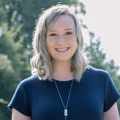
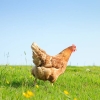
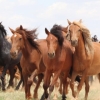
Comments